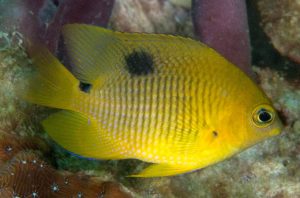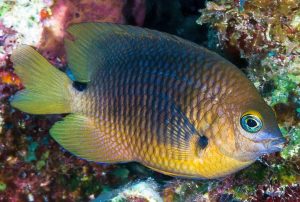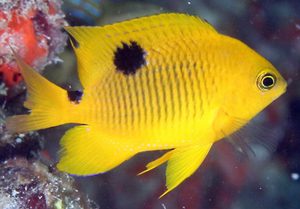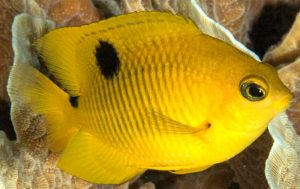Threespot Damselfish (Stegastes planifrons) known to tropical fish keeping enthusiasts as Honey Gregory Damselfish are found in the Western Atlantic with a range that extends to Florida, the Gulf of Mexico, the Caribbean Sea, and adjacent waters.
Threespot Damselfish are a demersal species that are found on both inshore and offshore reefs at depths from 1 to over 130 feet, where during daylight hours, they can be seen foraging mainly on algae. At night they are usually found at those depths sleeping in caves, crevices, holes, ledges, and among the tangled branches of staghorn corals.
Threespot Damselfish are an aggressive, non migratory, reef associated midwater species that occasionally make their way into the aquarium trade.
Adult Threespot Damselfish are usually encountered as solitary individuals or in pairs near the top of the outer edges of coral reefs in very shallow waters among abundant growths of algae.
Like Pink Smith Damselfish (Pomacentrus smithi) and other damselfishes species in the Caribbean and around the world; Threespot Damselfish are primarily herbivores that cultivate gardens of algae for food and areas for the females to deposit their eggs. In order to encourage growth of their preferred algae species, the fish meticulously tend to their gardens by removing small invertebrates and unwanted species of algae from their “plots”. Adults vigorously guard large territories and will aggressively chase intruders, including divers, out of their gardens. To have the greatest chance of success in courting a female, males spend a lot of time keeping their gardens at the highest quality.
Like several other species of damselfish; juvenile Threespot Damselfish often set up cleaning stations where they act like cleaner wrasses and feed on the external parasites of other fish species.
Adult Threespot Damselfish have a brownish gray body color with a dusky yellowish hue, several dark vertical lines following rows of scales, and a large black spot at the base of the dusky pectoral fins.
Juvenile Stegastes planifrons have a bright yellow body color with a few tiny blue spots on the head, upper
body, and one on the upper iris. They have three distinctive black spots that identify them; one located at the base of the dorsal fin, one dorsally on the caudal peduncle, and a smaller black spot at the upper base of the pectoral fin. The spots are often rimmed a faint blue color and in very young juveniles, the pectoral spot is absent.
The Threespot Damselfish can easily be confused with the Cocoa Damselfish (Stegastes variabilis) with yellow anal, caudal, and pectoral fins; and the Longfin Damselfish (Stegastes diencaeus) with an anal fin with a blue margin.
Threespot Damselfish or Honey Gregory Damselfish are a large, aggressive, species that should be housed alone in a reef or FOWLR aquarium of at lest 55 gallon capacity with a sandy or fine crushed coral substrate and plenty of mature live rock arranged into caves, crevices, and overhangs for hiding among. Regardless of age or size, Threespot Damselfish will quickly become the dominant species in the tank and although they are extremely aggressive, they are still considered reef safe. In larger aquariums, they can be housed with other semi aggressive to aggressive species so long as plenty of free swimming area and mature live rock is provided.
Threespot Damselfish have reportedly been bred in an aquarium environment. Adults display distinct pairing during breeding and form breeding pairs that vigorously maintain large territories. Males work to maintain high quality gardens to have the best chance at success in courting a female.
When a receptive female decides to spawn in the male’s territory and deposits her adhesive eggs on the fronds of algae growing in his garden, the male will immediately fertilize the demersal eggs and guard the nest while constantly oxygenating the eggs with his fins until they hatch out. Both parents will usually aggressively defend the eggs from wrasses, parrotfish, and other predators. Once hatched out, the tiny fry in their larval stage will drift with the current as plankton feeding on zooplankton and phytoplankton for up to 20 days before settling to the bottom as partially developed damselfish. The fry are born male or female and will remain that way for the rest of their lives.
Threespot Damselfish feed primarily on algae that they propagate as well as harpacticoid copepods, small gastropods, eggs of mollusks, sponges, polychaetes, marine worms, sponges, and hydroids. In an aquarium environment, they should be fed a variety of herbivore preparations, occasional meaty items, and flaked foods. High quality omnivore flakes and pellets, along with fresh, frozen, or freeze dried algae, Mysis shrimp
, brine shrimp, krill, plankton
, chopped shrimp, scallops, clam, etc. will all be eagerly consumed. Feeding small portions 2 to 3 times a day is recommended.
Threespot Damselfish (Stegastes planifrons) are only occasionally available to tropical fish keeping enthusiasts online from a variety of wholesale and retail sites at prices from $19.99 to $29.99 at a purchase size of: 1.5″ – 2.25″.
Minimum Tank Size: 55 gallons
Aquarium Type: Reef or FOLR
Care Level: Easy
Temperament: Semi Aggressive
Aquarium Hardiness: Hardy
Water Conditions: 72-78°F, dKH 8 to 12, pH 8.0 – 8.4, sg 1.020-1.025
Max. Size: 5″
Color Form: Gray, Black, Yellow
Diet: Omnivore
Compatibility: Reef Safe
Origin: Caribbean, Bahamas, Florida, Bermuda, Gulf of Mexico
Family: Pomacentridae
Lifespan: 5 years
Aquarist Experience Level: Beginner






